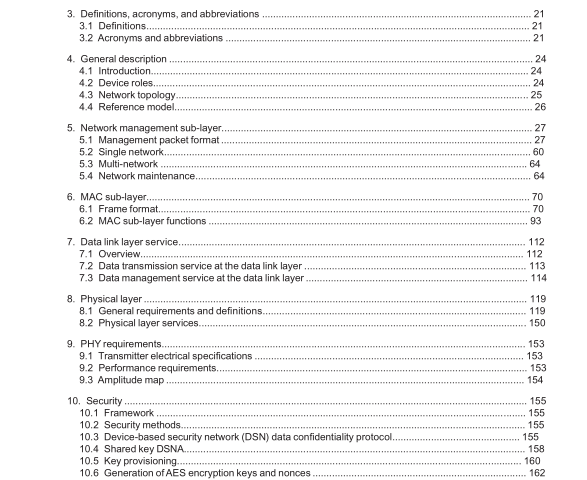IEEE 1901.1-2018 pdf download.IEEE Standard for Medium Frequency (less than 12 MHz) Power Line Communications for Smart Grid Applications
This standard specifies physical (PHY) and media access control (MAC) layers of the medium frequency band (less than 12 MHz) broadband power line communication technology for smart grid applications (SGPLC) based on orthogonal frequency division multiplexing (OFDM) (e.g., FTT and/or wavelet OFDM). This standard coexists with IEEE Std 1901™-2010, IEEE Std 1901.2™-2013 [B1], and IEEE Std 1901.2a™-2015 [B2].
The standard addresses the necessary security requirements that assure communication privacy and allow use for mission critical and security sensitive services and applications. This standard also defines the approach that is geared towards achieving an extended communication range in comparison with the existing power line communication technologies operating in similar frequency bands.
2. Normative references
The following referenced documents are indispensable for the application of this document (i.e., they must be understood and used, so each referenced document is cited in text and its relationship to this document is explained). For dated references, only the edition cited applies. For undated references, the latest edition of the referenced document (including any amendments or corrigenda) applies.
FIPS 1 97,Advanced Encryption Standard (AES), 2001.
IEEE Std 802™-2001, IEEE Standard for Local and Metropolitan Area Networks: Overview and Architecture. 4
IEEE Std 1901™-2010, IEEE Standard for Broadband over Power Line Networks: Medium Access Control and Physical Layer Specifications.
3. Definitions, acronyms, and abbreviations
For the purposes of this document, the following terms and definitions apply. The IEEE Standards Dictionary Online should be consulted for terms not defined in this clause. 6
3.1 Definitions
amplitude map: A table of amplitude scaling values assigned to each carrier.
association: A service used to create subordinate relationships among members on a communication network.
beacon: A management packet that is sent by the central coordinator (CCO), proxy coordinator (PCO), or station (STA). The beacon carries information about network management and maintenance, and is used for a specified purpose.
beacon period: The interval at which the central coordinator (CCO) sends a central beacon based on the network scale.
broadband carrier communication network: The broadband carrier communication network supports the transmission of digital data over electrical power lines.
direct route: Routes of one hop.
host: Computing system with integrated IEEE 1901.1 communications module.
indirect route: Routes of more than one hop.
MAC address: A media access control address. The MAC addresses and organizationally unique identifiers (OUIs) in this standard are represented as described in IEEE Std 802™-2001.
multi-network coordination: The process in which the central coordinators (CCOs) on different networks perform negotiation to ensure that the networks can mutually coexist.
network identifier (NID): Uniquely identifies a broadband carrier communication network.
whitelist: A list of MAC addresses of stations (STAs) allowed to connect to the communication network.
3.2 Acronyms and abbreviations
AES Advanced Encryption Standard
AFE analog front end
AGC automatic gain controller
AWGN additive white Gaussian noise
BCD binary coded decimal
BEHDR beacon entry header
BIFS burst inter frame space
BMI beacon management information
BPC beacon period count
BPCS beacon payload check sequence
BPSK binary phase shift keying
BT beacon type
BTS beacon time stamp
BTT beacon transmit
time
CBC cipher block
chaining
CCO central coordinator
CIFS contention inter frame space
CP cyclic prefix
CRC cyclic redundancy check
CSMA/CA carrier sense multiple access with collision avoidance
CST carrier screening table
CTS clear to send
DAK device access key
DFE dynamic frequency exclusion
DSN device-based security network
DSNA Device-Based Security NetworkAssociation
DTEI destination terminal equipment identifier
EIFS extended inter frame space
EKS encryption key select
ENC encoder
EOF end of frame
ETX expected transmission count
FC frame control
FCCS frame control check
sequence
FDM frequency domain
multiplex
FEC forward error correction
FFT fast Fourier transformation
FL frame length HLE
high level entity
ICV integrity check value
IFFT inverse fast Fourier transform
IP internet protocol.IEEE 1901.1 pdf download.IEEE-1901.1-2018IEEE 1901.1-2018 pdf download
IEEE 1901.1-2018 pdf download

Leave a Reply